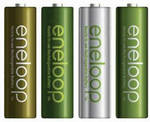Both still showing in stock for me.
No code required. Cheaper than last deal even without code.
Apparently 1900mah - 2000mah capacity is just a maximum rated capacity, and both will have similar capacity.
4 Pack $17.89: https://www.ebay.com.au/itm/4x-Panasonic-Eneloop-AA-Recharge…
8 Pack $31.99: https://www.ebay.com.au/itm/8x-Panasonic-Eneloop-AA-Recharge…
Here is a link to my post with my bad experience with "Made in China" duds: https://www.ozbargain.com.au/node/441634
I have decided to remove my post, as it is unfair to judge a products reputation based on a single bad experience.





Any recommendations on a charger for these batteries?